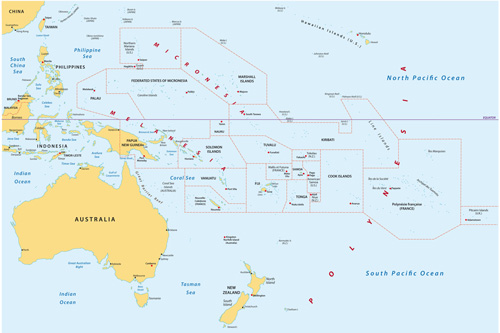Reading Comprehension Text and Exercises
Oceania
Oceania is a region in the Pacific Ocean, consisted of about 25,000 islands, many of which are uninhabited.
Oceania is also defined as one of the seven continents, the smallest one in terms of land area.
The name Oceania is a translation of French Océanie, which derives from the Latin word oceanus and the Greek word okeanos, meaning "ocean."
The name was given to the region by a geographer called Conrad Malte-Brun because, unlike with other continents connected by land, it is the ocean that links different nations together into Oceania.
The continent is further divided into four sub-regions: Micronesia, Melanesia, Polynesia, and Australasia.
(Click on the map to see a larger version.)
Click Here for Step-by-Step Rules, Stories and Exercises to Practice All English Tenses
A Brief History of Oceania
- Certain areas of Oceania, such as Papua New Guinea, have the earliest records of human civilization outside Africa. The first settlers reached these areas as early as 50,000 years ago.
- In the 16th century, several large Spanish expeditions (journeys organized to make some discovery) reached the islands in the North Pacific.
- A century later, the Dutch began to arrive in Oceania. Abel Tasman, a Dutch explorer and merchant (trader), was the first one to visit New Zealand and the now-Australian island of Tasmania, named after him.
- James Cook, a famous British explorer, made three voyages to Oceania in the 18th century. He created precise maps of some areas such as New Zealand and made the first contact with aboriginal (native) tribes.
- Following his journeys, much of Oceania was colonized and became part of the British Empire. Other European nations such as France, Spain, the Netherlands, and Germany have all established several colonies on different islands in Oceania.
- Australia and New Zealand led the way to independence from European colonizers in the early 20the century, while many smaller islands declared independence in the 1970s.
- Today, Oceania is a very diverse region, with mixtures of native people, those of European descent, and a great number of immigrants coming from all over the world. After Australia, Papua New Guinea is the most populated island in Oceania with 5.9 million people.
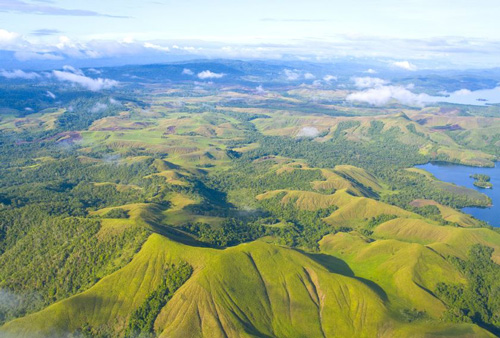
Micronesia
The name "Micronesia" derives from Greek mikros, meaning "small" and nesos, meaning "island." Such a name is perfect for this west Pacific sub-region of Oceania which is comprised of over 2,100 small islands.
Some of the islands of Micronesia were first settled several thousand years ago when people migrated from South Asia.
The first European to reach one of the islands, called Marianas, was the great Portuguese explorer Ferdinand Magellan (in 1521 AD).
The largest island in Micronesia is Guam, a territory of the United States. The United States captured the island in the Spanish-American War in 1898.
Another Micronesian island is Nauru, the second least-populated country in the world after Vatican City in Italy, with only around 11,000 residents. This small island country is surrounded by an amazing coral reef, which is home to a rich ocean life.
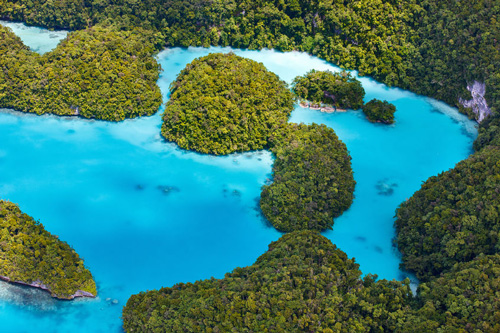
Melanesia
Melanesia is a sub-region which lies south from Micronesia, occupying the southwestern area of the Pacific.
Its name comes from Greek melas which means "black" and nesos, meaning "island." The expression "island of black (people)," referring to the dark skin of the native people, was first used in 1832 by Jules Dumont d'Urville, a French explorer.
There are four independent countries in Melanesia: Vanuatu, the Solomon Islands, Fiji, and Papua New Guinea.
The population living in these countries is very diverse. For example, there are 1319 known languages spoken in Melanesia! Most of these languages are spoken in Papua New Guinea. This country is one of the most rural areas in the world, with only one-fifth of its 8 million people living in cities.
Being one of the earliest inhabited places by humans, Papua New Guinea still has parts which are completely unexplored. This means there are plants, animals, and even people, which still remain undiscovered.
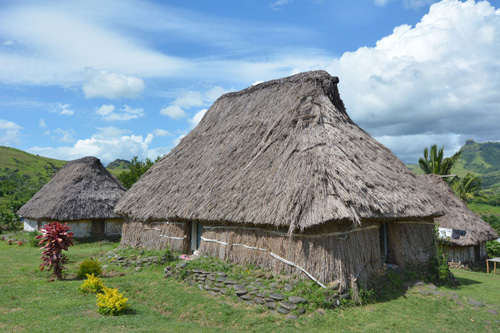
Polynesia
The name Polynesia (in Greek polys means "many" and nesos means "island") was first used in 1756 by Charles de Brosses, a French writer, to describe this sub-region of thousands of islands scattered around the central and southern areas of the Pacific.
This sub-region includes several independent nations as well as overseas territories like French Polynesia (a French overseas territory comprising of about 120 islands, one of which is Tahiti).
While the people of Polynesia share some traits, they are divided into two different cultural groups: East and West Polynesia.
The West Polynesians, including the people of Tuvalu (an island country north of Fiji) and Samoa (an island group east-northeast of Fiji), have had well-developed institutions for a long time.
The East Polynesian cultural group is comprised of smaller islands such as Rapa Nui (an island of Chile). Rapa Nui is also known as Easter Island (because it was encountered by Dutch explorers on Easter Day). It is famous for its 887 enormous statues of human figures, built by the native people between 1250 and 1500.
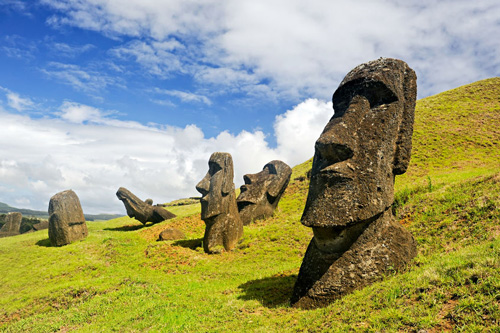
Australasia
Australasia is a sub-region which includes Australia, New Zealand and several neighboring islands in the south Pacific.
The French writer Charles de Brosses also coined this terms, which derives from the Latin australis, meaning "southern," to describe a place "southern from Asia."
In the early 20th century, this name was used for the combined Australia and New Zealand sports team, when these two countries competed together at the Olympic Games in 1908 and 1912.
Australia has the largest land area and population in Oceania. Most of the animals in Australia, such as kangaroos and koalas, are found nowhere else in the world because they have been isolated by the ocean for millions of years.
The large island of New Zealand, which lies some 930 miles (1,500 km) southeast of Australia, is known for its sheep industry. There are about 11 sheep for every person in New Zealand, meaning 44 million of them!

Comprehension Exercises
Vocabulary Questions
- What does "voyage" mean?
- a short flight by plane
- a journey made on foot
- a long journey by ship
- What does "descent" mean?
- being very clumsy, falling down frequently
- being related to someone from the past
- physical characteristics of a person
- What does "scattered" mean?
- standing closely next to one another
- undiscovered and unexplored
- located or happening in a large area
- What does "trait" mean?
- a long string
- a quality of a person, characteristic
- a rural area
- What does "capture" mean?
- to take something by force
- to sell something for a lot of money
- to receive something as a gift
Collocation Questions
- James Cook created a __________ map of New Zealand.
- specific
- precise
- definite
- There are thousands of __________ islands in Oceania.
- unsettled
- unpeopled
- uninhabited
- Polynesia consists of thousands of islands scattered __________ the Pacific.
- around
- by
- of
- New Zealand is known for its large sheep __________.
- production
- business
- industry
- Many people who live in Oceania today are __________ European descent.
- from
- of
- on
- Australia and New Zealand __________ the way to independence from European colonizers.
- led
- steered
- guided
- There are many __________ plant and animal species in New Guinea.
- mysterious
- undiscovered
- unearthed
- James Cook made the first __________ with several aboriginal tribes.
- touch
- communication
- contact
- In the 20th century, New Zealand and Australia had a __________ sports team.
- combined
- blended
- mingled
- The ocean __________ different nations together into a continent.
- associates
- links
- ties
Wh Questions
- Which the smallest island country in Oceania?
- New Zealand
- Nauru
- Papua New Guinea
- Where do koalas live?
- all over Oceania
- only in Australia
- only in Papua New Guinea
- What is the island of Rapa Nui famous for?
- large statues
- a Christian holiday
- a beautiful coral reef
- Who were the first Europeans to visit the island of Tasmania?
- the French
- the British
- the Dutch
- How did Guam become part of the United States?
- after the Guam elections
- in the Spanish-American War
- upon the declaration of independence
Evaluating Statements
- Based on the information in this lesson, which statement is true?
- All four sub-regions of Oceania have names which derive from the Greek word nesos.
- Three sub-regions of Oceania have names which derive from the Greek word nesos.
- Based on the information in this lesson, which statement is false?
- The British were the only ones who managed to colonize Oceania.
- Several European empires colonized Oceania.
True or False?
- Based on the information in this lesson, is the following statement true or false?
"Out of the 1319 languages spoken in Melanesia, only 12 can be heard in Papua New Guinea." - True
- False
- Based on the information in this lesson, is the following statement true or false?
"Both James Cook and Ferdinand Magellan visited Oceania on their journeys." - True
- False
Answer Key
1. C | 2. B | 3. C | 4. B | 5. A | 6. B | 7. C | 8. A | 9. C | 10. B | 11. A | 12. B | 13. C | 14. A | 15. B | 16. B | 17. B | 18. A | 19. C | 20. B |21. B | 22. A | 23. B | 24. A
Get Updates, Special Offers, and English Resources
Download your FREE GIFT (the first two chapters of
English Short Stories Book and Workbook)
as soon as you join!

By submitting your email, you consent to receiving updates and newsletters from us and to the sharing of your personal data with third parties for the purposes of sending you communications. We will not spam you. You can unsubscribe at any time. For more information, please see our privacy policy.



